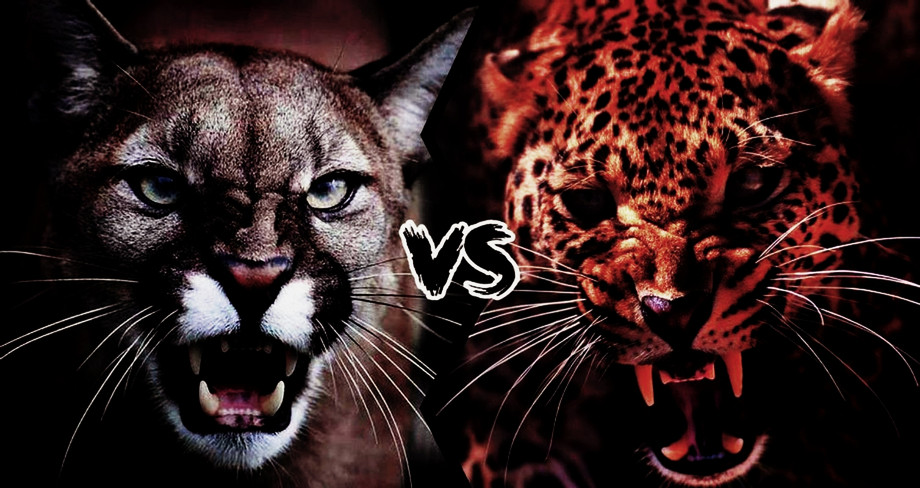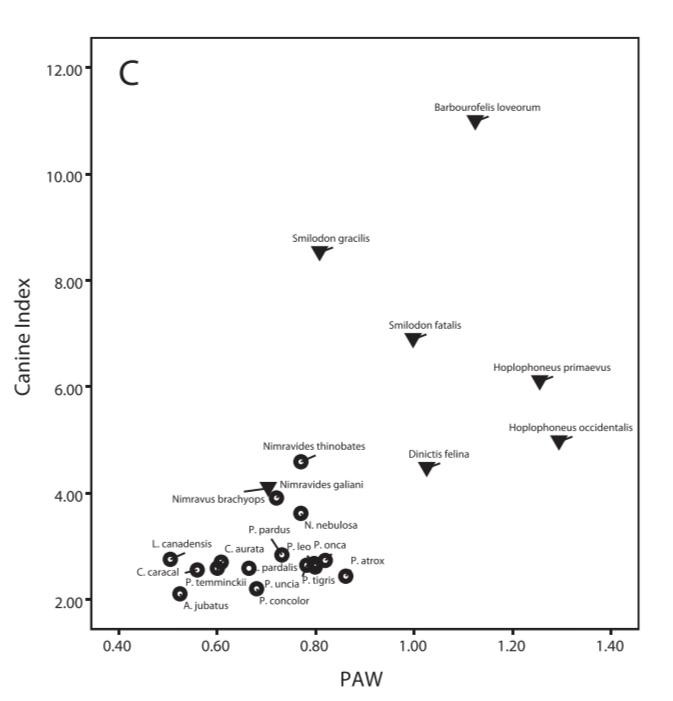Scapula Length Index :
Scapula length divided by Forelimb length. Higher score Indicates greater speed of movement via relative proportions of components of the proximal forelimb as well as exertion of greater force from the forelimb.
P.Concolor : 30%
P.Pardus : 33%
Edge: P.Pardus
Scapula Length Index 2 :
Scapula length divided by presacral column length. Higher score Indicates greater speed of movement via relative proportions of components of the proximal forelimb as well as exertion of greater force from the forelimb.
P.Concolor : 20%
P.Pardus : 20%
Edge: Draw
Spina Scapula Index :
Spina scapula/scapula length. Higher score Increases attachment point for several muscles such as trapezius muscles.
P.Concolor(hyphen) : exact value unknown
P.Pardus(open triangle) : exact value unknown
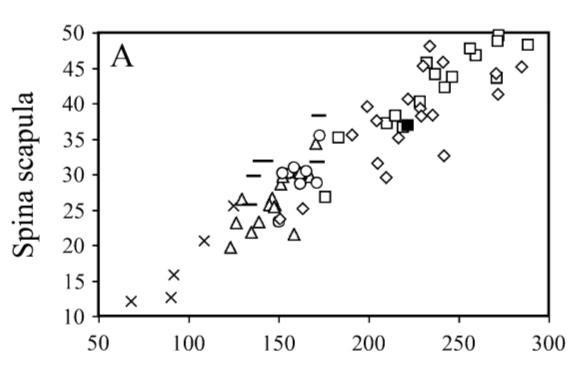
Edge : P.Concolor (P.Pardus might close the gap or shift it in its favor if we consider its relatively longer scapula)
Infraspinous Fossa Index :
Higher score Indicates greater infraspinatus muscle attachement which functions a rotator cuff muscle providing glenohumeral stability.
P.Concolor(hyphen) : exact value unknown
P.Pardus(open triangle) : exact value unknown
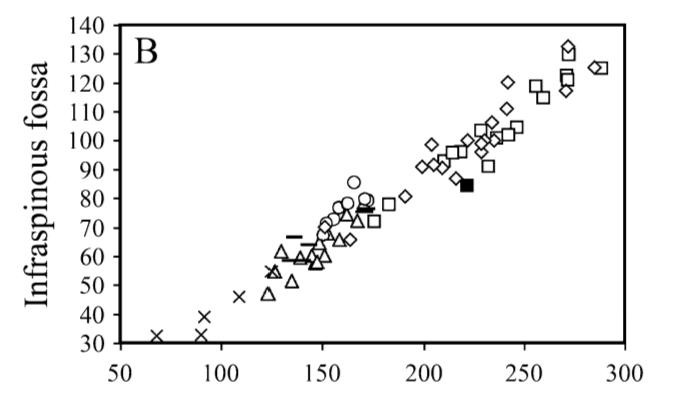
Edge : Draw (P.Pardus if we take into consideration its proportionally Longer Scapulae)
Supraspinous Index :
supraspinous fossa / scapula length. Higher score Indicates greater supraspinatus muscle attachement. This muscle helps to resist the gravitational forces which act on the shoulder joint to pull from the weight of the upper limb downward and to stabilize the shoulder joint by keeping the head of the humerus firmly pressed medially against the glenoid fossa of the scapula resulting in exertion of greater force from the forelimb.
P.Concolor(hyphen) : exact value unknown
P.Pardus(open triangle) : exact value unknown
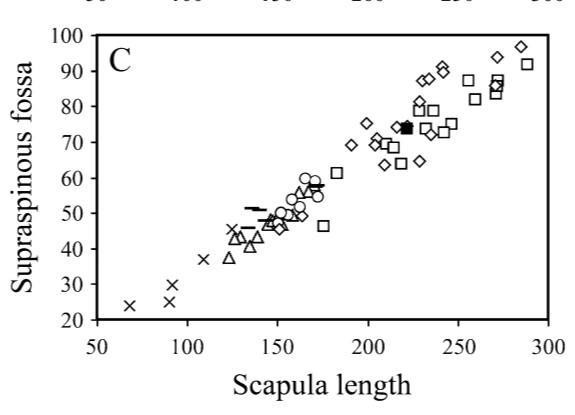
Edge : P.Concolor (P.Pardus might close the gap or shift it in its favor if we consider its relatively longer scapula)
Deltoid Index :
Deltoid crest length divided by humerus articular length. Higher score Displays greater mechanical advantage of deltoid muscles at the shoulder joint and provides a larger inlever and thus greater inforce.
P.Concolor : ~46%
P.Pardus : ~56%
Edge : P.Pardus
HRI :
It is humerus mediolateral diameter at mid-shaft/humerus length.Robust forelimb bones protect the animal from violent stresses during grappling.
P.Concolor : 8%
P.Pardus : 8%
Edge : Draw
HRI2 :
It is humerus anteroposterior diameter at mid-shaft/humerus length. Robust forelimb bones protect the animal from violent stresses during grappling.
P.Concolor : 11%
P.Pardus : 12%
Edge : P.Pardus
HCSI :
Cross-Section/divided by Length of humerus. A higher score determines a greater Humeral robusticity.
P.Concolor : exact value unknown
P.Pardus : exact value unknown
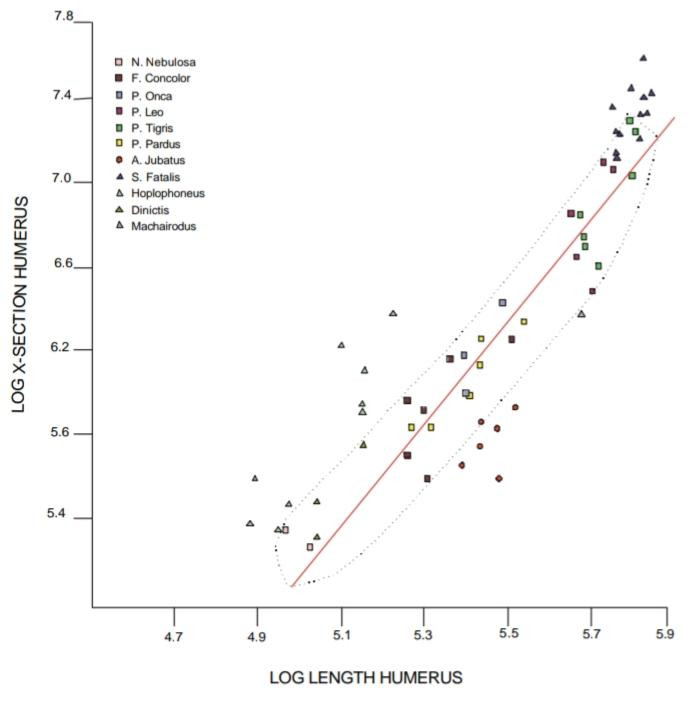
Edge : Draw
HCMI :
Often-used variable in analyses of bone strengths in locomotion. The higher the ratio is, the thicker the Humeral bone is.
P.Concolor : 29%
P.Pardus : 29%
Edge : Draw
Lx/length :
This measure is used to estimate aspects of long Humeral midshaft bone strength in bending about mediolateral plane.
P.Concolor(n°29) : exact value unknown
P.Pardus(n°21) : exact value unknown
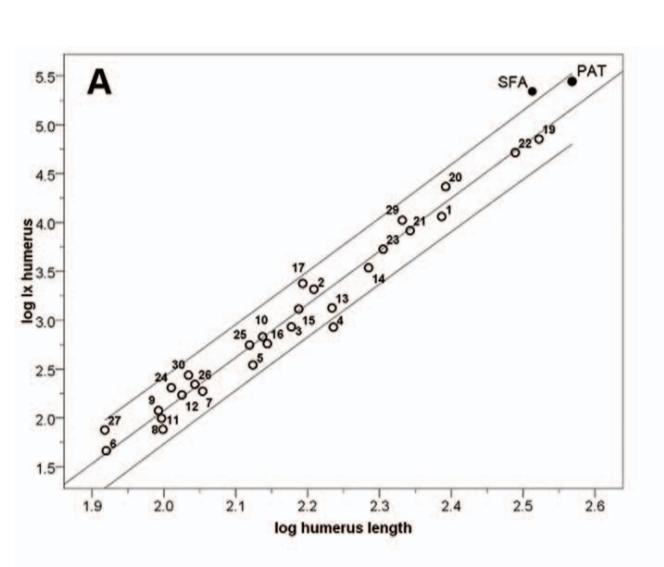
Edge : P.Concolor
Ly/length :
This measure is used to estimate aspects of long Humeral midshaft bone strength in bending about craniocaudal plane.
P.Concolor(n°29) : exact value unknown
P.Pardus(n°21) : exact value unknown
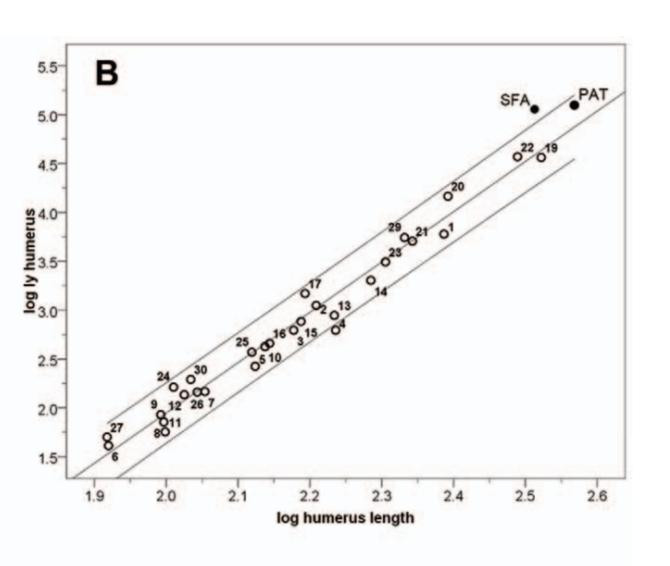
Edge : P.Concolor
J/2/length :
This measure is used to estimate aspects of long Humeral midshaft bone strength in average rigidity in non-axial loading.
P.Concolor(n°29) : exact value unknown
P.Pardus(n°21) : exact value unknown
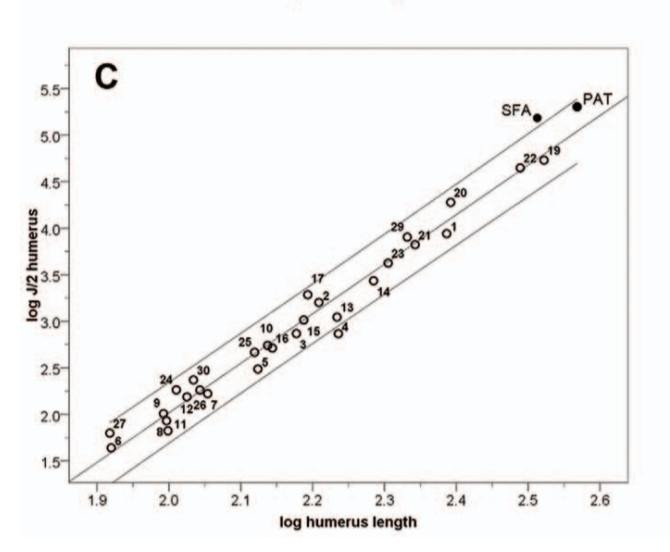
Edge : P.Concolor
CA/Length :
This measure is used to estimate aspects of long Humeral strength in axial compression.
P.Concolor : 80%
P.Pardus : 82%
Edge : P.Pardus
KML :
values closer to 100% signify relatively thinner cortical bone and values closer to 0% signify relatively thicker Humeral cortical bone.
P.Concolor : 71%
P.Pardus : 60%
Edge : P.Pardus
KCC :
values closer to 100% signify relatively thinner cortical bone and values closer to 0% signify relatively thicker cortical Humeral bone.
P.Concolor : 72%
P.Pardus : 67%
Edge : P.Pardus
HDWI :
It is Humeral distal width/Humeral length ratio, correlated with resistance to stresses at the elbow joint. A higher score also increases muscle attachement.
P.Concolor : 24%
P.Pardus : 24%
Edge : Draw
HEI :
The HEI index measures the relative size of wrist stabilizing muscles and well as several grasping muscles in area which facilitate prey grasping such as m. pronator teres, m.extensor carpi radialis, m. extensor carpi ulnaris, m. flexor carpi radialis,m.flexor carpi ulnaris m. extensor digitorum communis, m. extensor digitorum lateralis, m.flexor digitorum superficialis, m. palmaris longus,and m. flexor digitorum profundus. These muscles also likely help stability, pushing, and agility when legs are on ground.
P.Concolor : 24%
P.Pardus : 24%
Edge : Draw
HCI :
This is a measure of the humerus joint surface size near elbow. More positive PC1 scores indicate greater forearm mobility and stability during grappling and also likely when feet are on ground during a struggle as well as an increased ability to better distribute large loads.
P.Concolor(n°30) : exact value unknown
P.Pardus(n°22) : exact value unknown
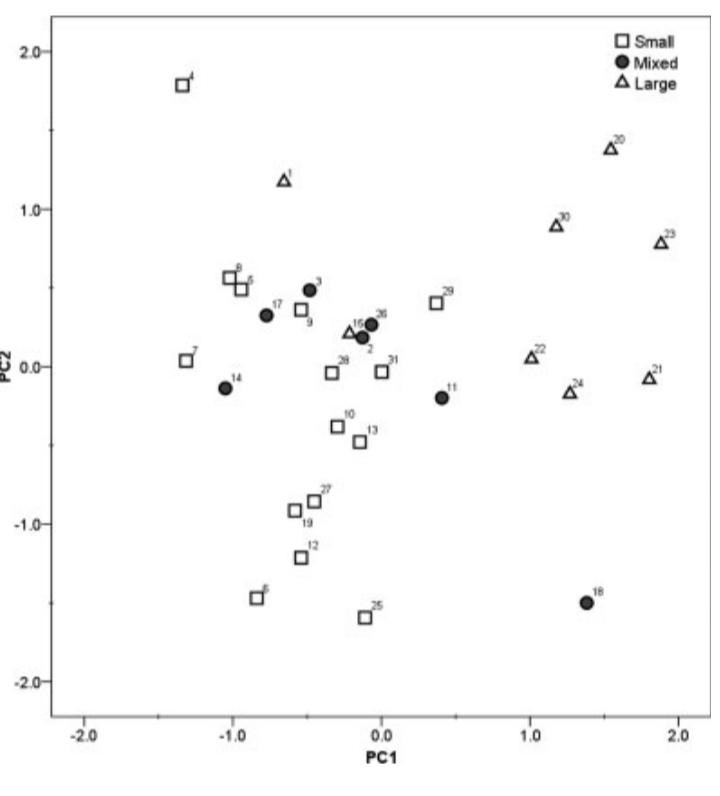
Edge : P.Concolor
PC2 :
Scoring intermediate or low on PC2 are carnivorans that use their forelimbs to subdue,manipulate or excavate food items.Carnivorans scoring low on PC2, i.e. grapplers like felids, have relatively shallow trochlear furrows and relatively large and distally-projecting medial trochlear flanges. These features provide extra stability against forces acting in a nonparasagittal plane.
P.Concolor : 1,633
P.Pardus : 1,072
Edge : P.Pardus
HAA :
This is another measure of area of where humerus terminates in elbow. More positive PC1 scores are associated with better grappling and distributing heavier loads.
P.Concolor(n°30) : exact value unknown
P.Pardus(n°22) : exact value unknown
Edge : P.Concolor
Brachial Index :
This measures radius length/humerus length. Lower scores in this ratio indicate greater forelimb muscle mechanical advantage and results in stronger muscles all else being equal.
P.Concolor : exact value unknown
P.Pardus : exact value unknown
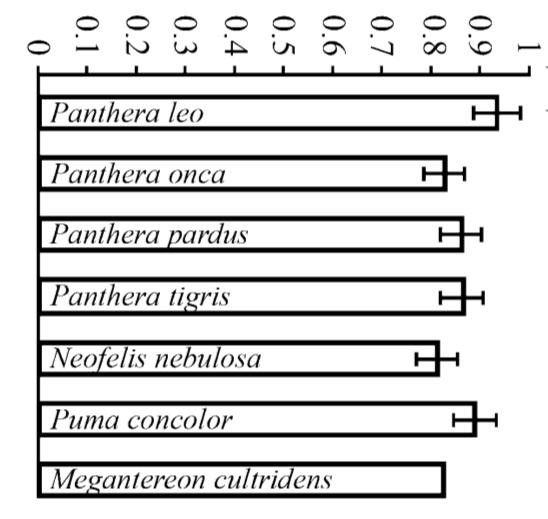
Edge : P.Pardus
Brachial Index 2 :
This measures ulna length/humerus length. Lower scores in this ratio indicate greater forelimb muscle mechanical advantage and results in stronger muscles all else being equal.
P.Concolor : exact value unknown
P.Pardus : exact value unknown
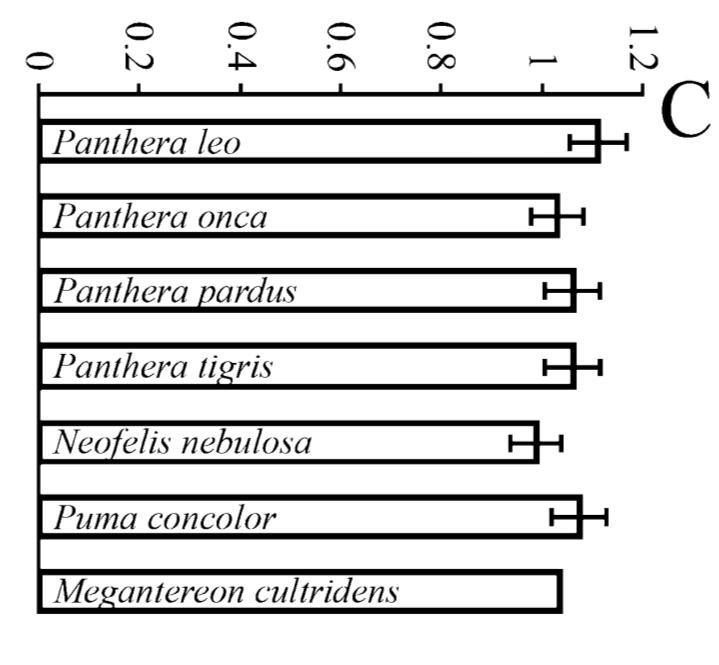
Edge : P.Pardus
Forelimb Proportion Index :
Length of proximal forelimb relative to length of distal forelimb ((Scapula length + Humerus length)/(Radius length + Metacarpal length)). Higher score Indicates greater degree of morphological specialization for producing large out-forces in the forelimb.
P.Concolor : 141%
P.Pardus : 149%
Edge : P.Pardus
OI :
This metrics estimates tricep muscle strength. High values indicate greater ability to push with arms all else being equal. This helps a grappling cat hold prey and also helps a canid push and knock down an opponent. In addition, higher values may indicate greater stability and ability to change direction in a fight as well as greater relative mechanical advantage of the triceps brachii and dorsoepitrochlearis muscles used in elbow extension.
P.Concolor : 21%
P.Pardus : 21%
Edge : Draw
URI :
This measures ulna anteroposterior diameter at midshaft divided by ulna length. As mentioned above for humerus robusticity, a robust ulna resists stresses on bones during fights and increases resistance to bites to the forelimb.
P.Concolor : 8%
P.Pardus : 9%
Edge : P.Pardus
RRI :
This measures radius mediolateral diameter at midshaft divided by radius length. As mentioned above for humerus robusticity, a robust radius resists stresses on bones
during fights and increases resistance to bites to the forelimb and increases muscle mass.
P.Concolor : 9%
P.Pardus : 9%
Edge : Draw
RRI2 :
This measures radius anteroposterior diameter at midshaft divided by radius length.As mentioned above for humerus robusticity, a robust radius resists stresses on bones during fights and increases resistance to bites to the forelimb and increases muscle mass.
P.Concolor : 6%
P.Pardus : 7%
Edge : P.Pardus
RAA :
This is another measure of radius where it terminates at wrist. More positive PC1 scores help to reinforce the forelimbs against the stresses encountered by large, struggling prey and to distribute heavier loads.
P.Concolor(n°30) : exact value unknown
P.Pardus(n°22) : exact value unknown
Edge : P.Concolor
RAI :
This is a measure of joint area where radius meets wrist joint. More positive PC1 scores indicate larger forces are put on joints either through larger muscles, or external stresses which helps grappling or ability to fight with feet on ground (i.e. ability to quickly change directions, stability, etc.).
P.Concolor(n°30) : exact value unknown
P.Pardus(n°22) : exact value unknown
Edge : P.Concolor
PAW :
This is a measurement of paw width on forelimbs and gives us an idea of how well-paws are designed to hold prey. In addition, relatively wider paws likely increase stability while feet are on ground.
P.Concolor : exact value unknown
P.Pardus : exact value unknown
Edge : P.Pardus
MCP :
proximal phalanx to metacarpal ratio, more negative PC2 scores offer increased surface area for grasping and grappling and greater relative proportions of proximal and distal elements of the manus and size of the palmar surface.
P.Concolor(n°30) : exact value unknown
P.Pardus(n°22) : exact value unknown
Edge : P.Pardus
MC3AA :
This is a measure of size of metacarpal at joints of finger. Higher PC1 Scores help stabilize the metacarpals against stresses from prey and climbing.
P.Concolor(n°30) : exact value unknown
P.Pardus(n°22) : exact value unknown
Edge : P.Concolor
MC3RI :
This measures the robusticity of metacarpal 3 or longest finger/digit. More negative PC1 scores may assist with grappling or stresses exerted with feet on ground during a fight.
P.Concolor(n°30) : exact value unknown
P.Pardus(n°22) : exact value unknown
Edge : P.Pardus
Studies Used For The Above Comparison :
https://www.tandfonline.com/doi/abs/10.1080/08912960600618073
https://www.researchgate.net/publication/7531697_Body_size_ofSmilodon_Mammalia_Felidae
https://onlinelibrary.wiley.com/doi/abs/10.1111/evo.12904
https://academic.oup.com/zoolinnean/article/142/1/91/2691231
As seen, the Leopard has relatively longer scapulae, greater deltopectoral crests,wider Humeri Shafts, shorter forelimbs, greater forelimb proportions, more robust ulnae,radii,wider paws, greater Manus proportions and more robust metacarpals while the Puma has proportionally greater humeri articular areas,radii articular areas,and metacarpal articular areas. We can notice that While Both Cats are very similar in size, the Leopard has an edge in overall shoulder and forelimb strength, as well as back robusticity :
With this mind, it's safe to say that the Leopard is a stronger and better grappler. Thus, if it fought a similarly sized Mountain Lion, the Panthera would win after a long struggle!

